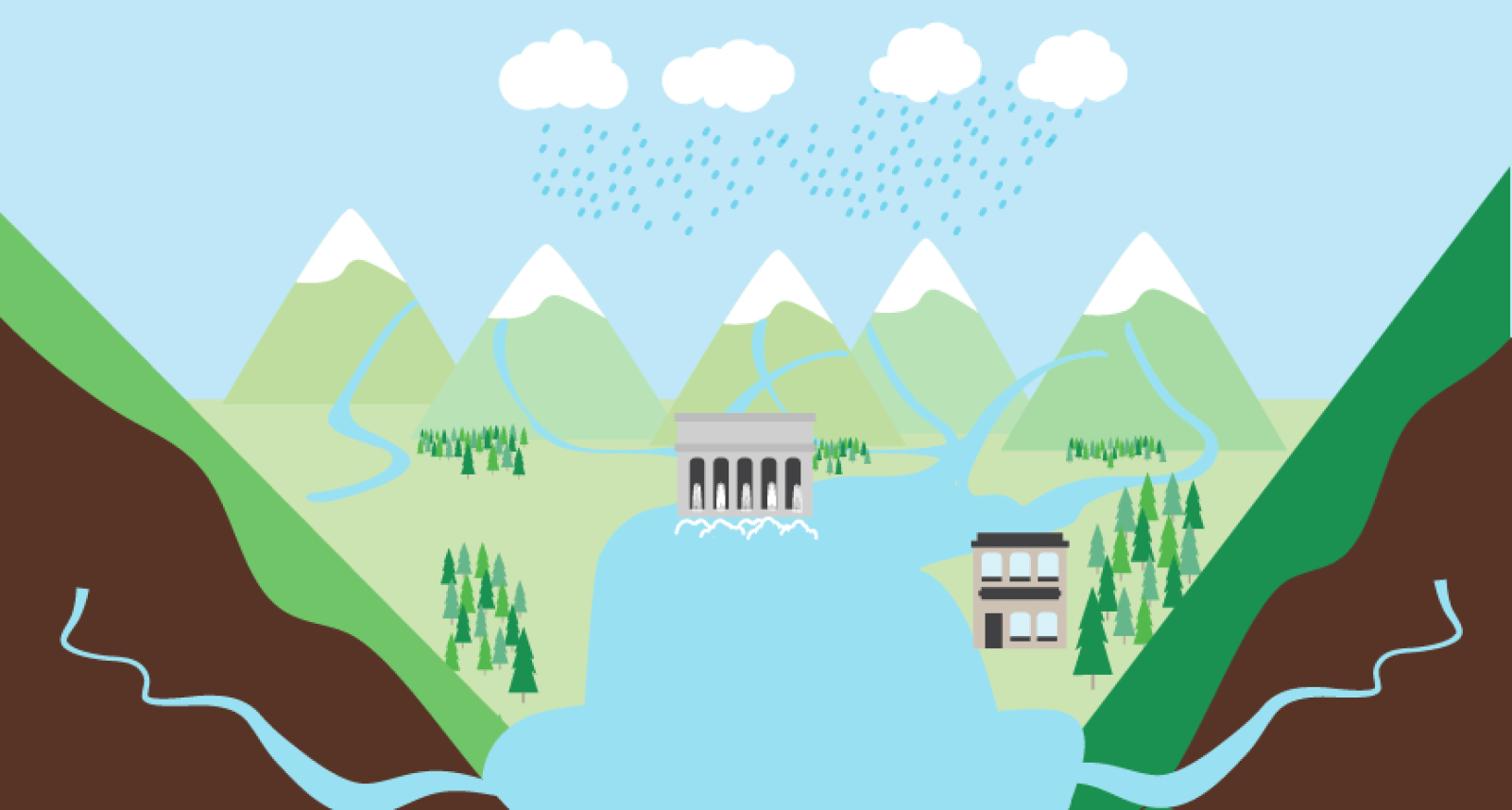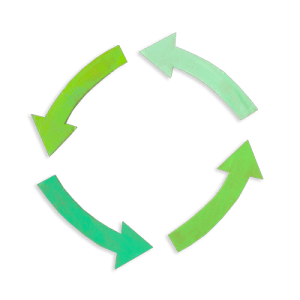
Overview
Explore how water is vital to all living things and have students make a simple paper model to see how water moves downhill and make a pledge or promise to appreciate, protect and conserve this life-giving resource.
Instructions
What you'll need
- "Water is life" slideshow
- "Water pledge" student handout, one per student
- "Downhill water" video demonstration
- Digital projector and screen
For the Downhill water activity
- One piece of paper per student (copy paper or similar, used on one side is preferable to save paper)
- One blue felt pen or crayon per student
- A spray bottle with water (one for the whole class)
- Rags or towel for water clean-up
Water is life
- Pull up the “Water is life” slideshow, and at slide 2 ask students to say what they see in the picture. At slide 3 share that Indigenous Peoples have many traditions, ceremonies and practices to honour water. Water is like a member of the family; it has a spirit and must be protected.
- At slide 4 ask students to choose which items we need to survive; the answers are shown on slide 5. As a class discuss how each of the items helps us to survive like shelter keeps us protected from the weather, and our bodies need nourishment and water.
- At slide 6 ask students to pick the one picture that would be the best place to live remembering how important water is to our survival. This can be done by holding up one, two or three fingers. Slide 7 reveals that the best place to live is near the river as we need fresh water to survive. Discuss that although number three has water, it is salty ocean water, so we cannot drink it.
- At slides 8 to 16 look at a picture, and together read the answers which describe what people could be doing. Students match their answer to the picture by holding up one, two or three fingers. The following slide reveals the answer. In this game students explore the many ways we use water in our lives. At slide 16 discuss that boats are a way to travel, hunt and explore.
- At slide 17 have students pick which picture needs water to survive, by holding up one, two or three fingers. Slide 18 shows that they ALL need water to survive! Have students consider other things that need water like different animals, plants, and insects.
- At slide 19 have a class discussion on how taking care of water is important for all living things. Taking care means not littering as litter can end up in the rivers, lakes and oceans.
- At slide 20 ask students what can happen if we waste water. If we use too much water we might not have enough, and the animals and forests might not have enough. We also use water to make electricity to power the lights in B.C., so we need to save water for that too.
- Slides 21 to 23 have students explore ways to save water so all species have enough. Students can hold up one or two fingers to choose the action that saves water.
- On slide 24 have students share other ideas for saving water. Ideas could include using a rain barrel in a garden, filling the bath halfway instead of to the top, and making sure you are not washing clothes that are still clean.
- At slide 25 invite students to quietly think about the ways they are thankful for water.
Downhill water
- Share that we will now explore how water moves and is collected, by creating a simple paper model. Discuss with students how water moves downhill, in rivers and streams, and collects in lakes.
- Pull up the “Downhill water” video demonstration to show students. The video demonstrates how to make the model using paper, felt pen, and sprayed water. Ask students to consider where the sprayed water might go.
- Provide each student with a piece of paper (used on one side is preferable to save paper) and as a class follow the steps:
- Step 1: Ask students to crumple the piece of paper. Show them how to crumple it by pinching it in the middle. This will result in a more mountain-like landscape.
- Step 2: Have students open the paper up again without flattening and lay it out. Imagine you are looking at mountains, rivers, and valleys.
- Step 3: Using the blue felt pen or crayons, have students draw where they think the rivers and lakes will be. Will they be on top of the mountain peaks or below in the valley and why?
- Step 4: As each student completes the rivers and lakes, move around and lightly spray their paper with water, sharing that this is rain, and see if the water flows down the rivers and lake that the students drew.
- After everyone has had a chance to see the water flow on their model, ask if the water flowed where they expected? Did they notice that the water ran downhill?
- Have students consider the area around the school. Are there hills and mountains, rivers and lakes affecting how the water moves here? Sometimes we can see water moving downhill in rivers, but sometimes it is moving underground, invisible but still there and always moving.
- The water moves downhill to fill up our lakes and rivers above and below ground. We share this moving water with animals, trees, people and to make electricity to power our lights in B.C.
Wrap up
- Ask students to share what they learned about water, like it’s important for all living things, and we need to honour it by taking care of the water, making sure there is enough for everyone, and keeping it clean.
- Invite students to share specific ways we can save water, to prepare for making a promise or pledge, like turning off the tap when brushing teeth, not leave the tap dripping and collecting rain to use in the garden.
- Provide each student with the “Water pledge” student handout. Students can thoughtfully make a pledge and draw a picture.
- Pledges can be posted in the classroom or corridor, or taken home and posted by a sink, to remind everyone to take care of the water.
Modify or extend this activity
- Take students outside to look for water under rocks, beneath trees, on hard surfaces, under the slide, in the grass and soil. Students can discover that water can be found everywhere even as ice or snow.
- Check out BC Hydro Power Smart for Schools activities: “Drops of wisdom” and “Honouring water” to explore Indigenous Peoples’ perspectives and relationship with water.
Curriculum Fit
These activities provide a link to the core competencies of the curriculum. The activities engage students in sharing ideas for ways we use water and using play to explore how water moves and can be found everywhere.
Core competencies
Communications
- Connect and engage with others (to share and develop ideas)
Thinking
- Creative thinking: generating ideas
- Critical thinking: question and investigate
Social awareness and responsibility
- Contributing to community and caring for the environment
The activities also connect to a variety of grade-specific curricular competencies and content in a variety of subjects including Arts Education, Science, and Social Studies.
Assessments
- Assess students’ understanding and appreciation that water is important for all living things, and we need to protect it.
- Assess students’ creativity making the paper model and understanding of how the water moves downhill.
- Assess students’ cooperation and teamwork outside working in groups to find water.
Teaching Notes
Water on the move
Learn about how water is necessary for life, always on the move and can be found everywhere provides a foundation for young people to protect and care for water.
BC Hydro’s environmental responsibility
BC Hydro uses the power of falling water to create clean, reliable electricity. BC Hydro has become a leading sustainable energy company by producing and delivering electricity, in environmentally and socially responsible ways. Check out Environmental responsibility for ways BC Hydro is protecting and sharing the resource.
Young people can take action
Young people can act at school, in their community and at home to protect and care for water. We can empower them with a deeper understanding of how essential water is to life and encourage them to share this message to respect, protect and honour water.







